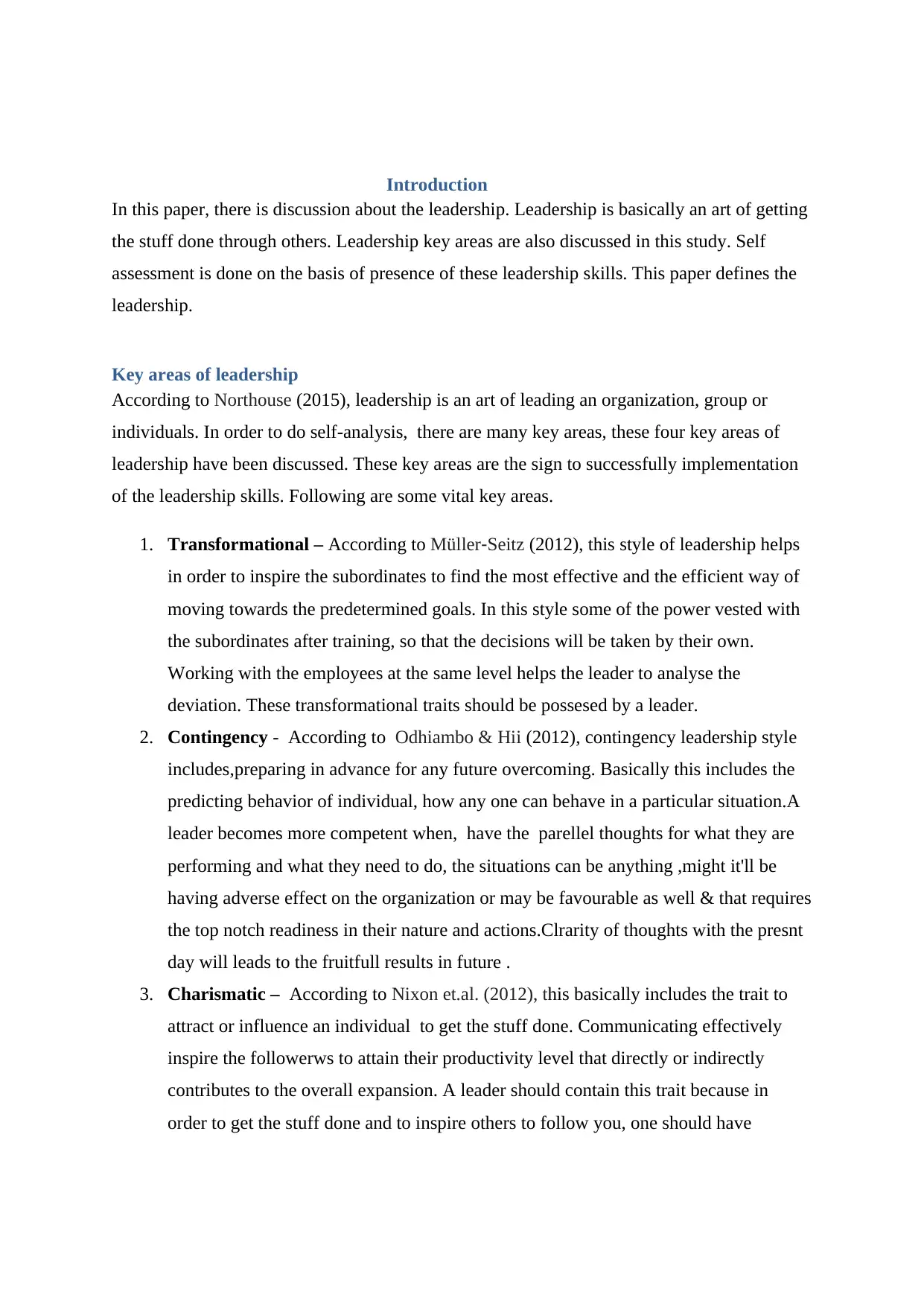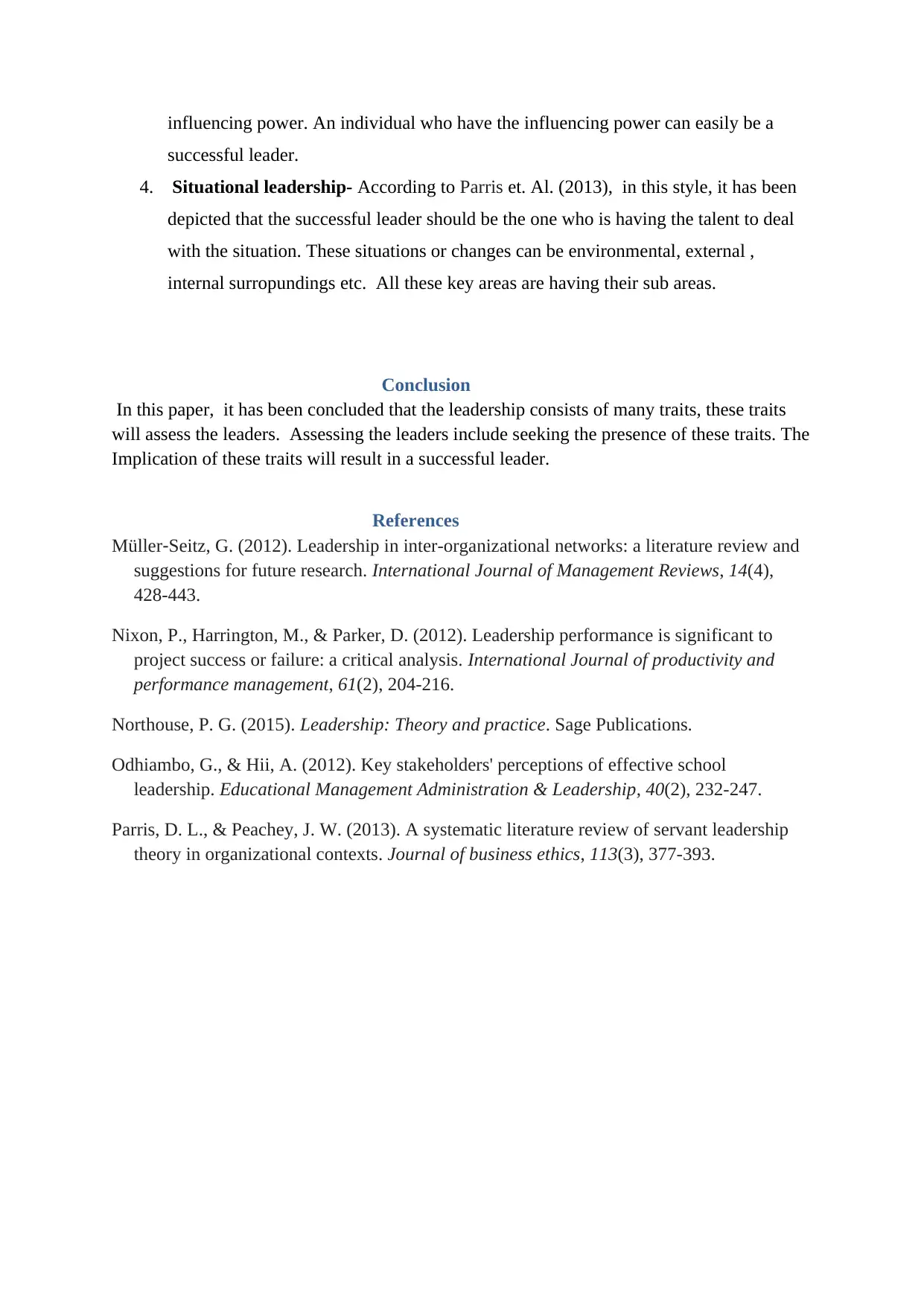An Examination of Leadership: Key Areas and Styles Explained
VerifiedAdded on 2020/03/04
|4
|695
|100
Essay
AI Summary
This paper offers an overview of leadership, defining it as the art of achieving goals through others and discussing its key areas. It explores four crucial leadership areas: transformational leadership, which inspires subordinates and empowers them to make decisions; contingency leadership, which emphasizes preparedness and adaptability to different situations; charismatic leadership, which highlights the ability to influence and inspire others; and situational leadership, which focuses on adapting leadership style to specific circumstances. The paper includes references to relevant research and concludes that a successful leader possesses these traits, which are essential for effective leadership.

Leadership areas
Paraphrase This Document
Need a fresh take? Get an instant paraphrase of this document with our AI Paraphraser

Introduction
In this paper, there is discussion about the leadership. Leadership is basically an art of getting
the stuff done through others. Leadership key areas are also discussed in this study. Self
assessment is done on the basis of presence of these leadership skills. This paper defines the
leadership.
Key areas of leadership
According to Northouse (2015), leadership is an art of leading an organization, group or
individuals. In order to do self-analysis, there are many key areas, these four key areas of
leadership have been discussed. These key areas are the sign to successfully implementation
of the leadership skills. Following are some vital key areas.
1. Transformational – According to Müller‐Seitz (2012), this style of leadership helps
in order to inspire the subordinates to find the most effective and the efficient way of
moving towards the predetermined goals. In this style some of the power vested with
the subordinates after training, so that the decisions will be taken by their own.
Working with the employees at the same level helps the leader to analyse the
deviation. These transformational traits should be possesed by a leader.
2. Contingency - According to Odhiambo & Hii (2012), contingency leadership style
includes,preparing in advance for any future overcoming. Basically this includes the
predicting behavior of individual, how any one can behave in a particular situation.A
leader becomes more competent when, have the parellel thoughts for what they are
performing and what they need to do, the situations can be anything ,might it'll be
having adverse effect on the organization or may be favourable as well & that requires
the top notch readiness in their nature and actions.Clrarity of thoughts with the presnt
day will leads to the fruitfull results in future .
3. Charismatic – According to Nixon et.al. (2012), this basically includes the trait to
attract or influence an individual to get the stuff done. Communicating effectively
inspire the followerws to attain their productivity level that directly or indirectly
contributes to the overall expansion. A leader should contain this trait because in
order to get the stuff done and to inspire others to follow you, one should have
In this paper, there is discussion about the leadership. Leadership is basically an art of getting
the stuff done through others. Leadership key areas are also discussed in this study. Self
assessment is done on the basis of presence of these leadership skills. This paper defines the
leadership.
Key areas of leadership
According to Northouse (2015), leadership is an art of leading an organization, group or
individuals. In order to do self-analysis, there are many key areas, these four key areas of
leadership have been discussed. These key areas are the sign to successfully implementation
of the leadership skills. Following are some vital key areas.
1. Transformational – According to Müller‐Seitz (2012), this style of leadership helps
in order to inspire the subordinates to find the most effective and the efficient way of
moving towards the predetermined goals. In this style some of the power vested with
the subordinates after training, so that the decisions will be taken by their own.
Working with the employees at the same level helps the leader to analyse the
deviation. These transformational traits should be possesed by a leader.
2. Contingency - According to Odhiambo & Hii (2012), contingency leadership style
includes,preparing in advance for any future overcoming. Basically this includes the
predicting behavior of individual, how any one can behave in a particular situation.A
leader becomes more competent when, have the parellel thoughts for what they are
performing and what they need to do, the situations can be anything ,might it'll be
having adverse effect on the organization or may be favourable as well & that requires
the top notch readiness in their nature and actions.Clrarity of thoughts with the presnt
day will leads to the fruitfull results in future .
3. Charismatic – According to Nixon et.al. (2012), this basically includes the trait to
attract or influence an individual to get the stuff done. Communicating effectively
inspire the followerws to attain their productivity level that directly or indirectly
contributes to the overall expansion. A leader should contain this trait because in
order to get the stuff done and to inspire others to follow you, one should have

influencing power. An individual who have the influencing power can easily be a
successful leader.
4. Situational leadership- According to Parris et. Al. (2013), in this style, it has been
depicted that the successful leader should be the one who is having the talent to deal
with the situation. These situations or changes can be environmental, external ,
internal surropundings etc. All these key areas are having their sub areas.
Conclusion
In this paper, it has been concluded that the leadership consists of many traits, these traits
will assess the leaders. Assessing the leaders include seeking the presence of these traits. The
Implication of these traits will result in a successful leader.
References
Müller‐Seitz, G. (2012). Leadership in inter-organizational networks: a literature review and
suggestions for future research. International Journal of Management Reviews, 14(4),
428-443.
Nixon, P., Harrington, M., & Parker, D. (2012). Leadership performance is significant to
project success or failure: a critical analysis. International Journal of productivity and
performance management, 61(2), 204-216.
Northouse, P. G. (2015). Leadership: Theory and practice. Sage Publications.
Odhiambo, G., & Hii, A. (2012). Key stakeholders' perceptions of effective school
leadership. Educational Management Administration & Leadership, 40(2), 232-247.
Parris, D. L., & Peachey, J. W. (2013). A systematic literature review of servant leadership
theory in organizational contexts. Journal of business ethics, 113(3), 377-393.
successful leader.
4. Situational leadership- According to Parris et. Al. (2013), in this style, it has been
depicted that the successful leader should be the one who is having the talent to deal
with the situation. These situations or changes can be environmental, external ,
internal surropundings etc. All these key areas are having their sub areas.
Conclusion
In this paper, it has been concluded that the leadership consists of many traits, these traits
will assess the leaders. Assessing the leaders include seeking the presence of these traits. The
Implication of these traits will result in a successful leader.
References
Müller‐Seitz, G. (2012). Leadership in inter-organizational networks: a literature review and
suggestions for future research. International Journal of Management Reviews, 14(4),
428-443.
Nixon, P., Harrington, M., & Parker, D. (2012). Leadership performance is significant to
project success or failure: a critical analysis. International Journal of productivity and
performance management, 61(2), 204-216.
Northouse, P. G. (2015). Leadership: Theory and practice. Sage Publications.
Odhiambo, G., & Hii, A. (2012). Key stakeholders' perceptions of effective school
leadership. Educational Management Administration & Leadership, 40(2), 232-247.
Parris, D. L., & Peachey, J. W. (2013). A systematic literature review of servant leadership
theory in organizational contexts. Journal of business ethics, 113(3), 377-393.
⊘ This is a preview!⊘
Do you want full access?
Subscribe today to unlock all pages.

Trusted by 1+ million students worldwide

1 out of 4
Related Documents
Your All-in-One AI-Powered Toolkit for Academic Success.
+13062052269
info@desklib.com
Available 24*7 on WhatsApp / Email
![[object Object]](/_next/static/media/star-bottom.7253800d.svg)
Unlock your academic potential
Copyright © 2020–2025 A2Z Services. All Rights Reserved. Developed and managed by ZUCOL.





